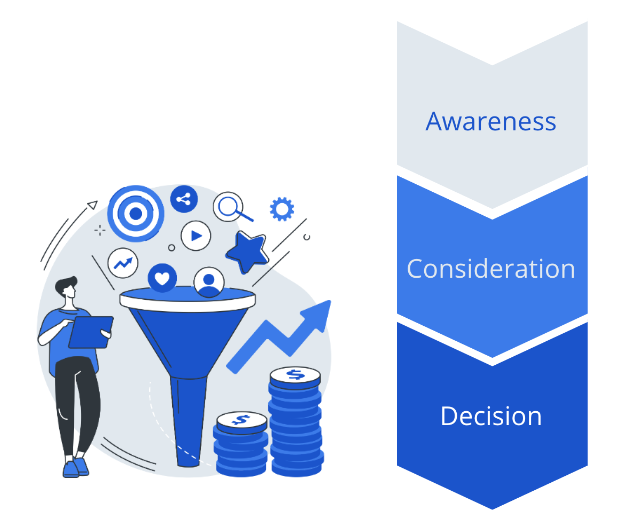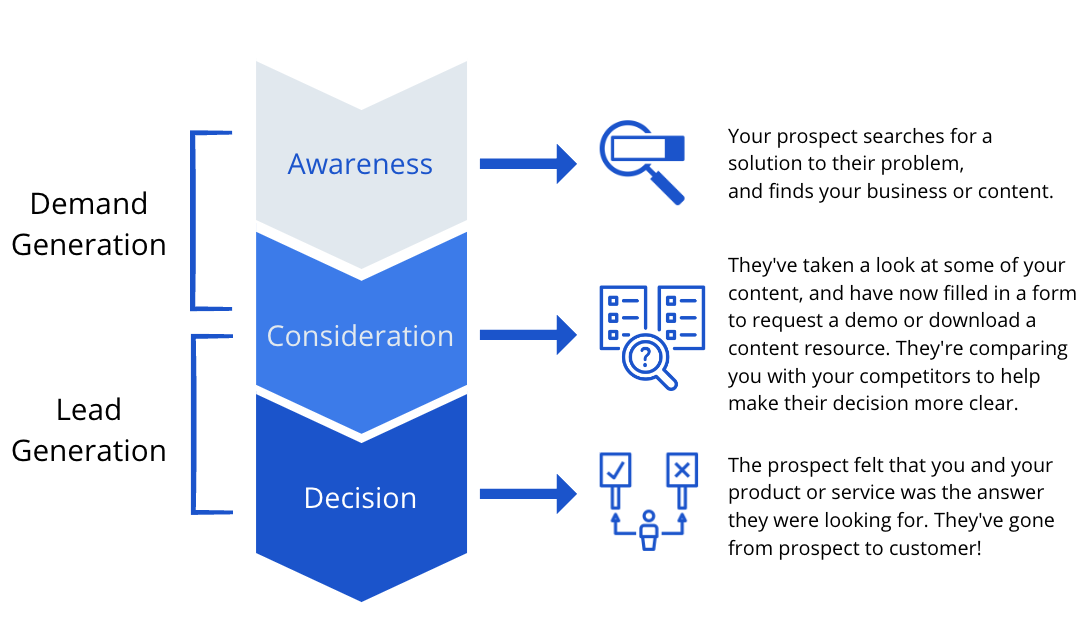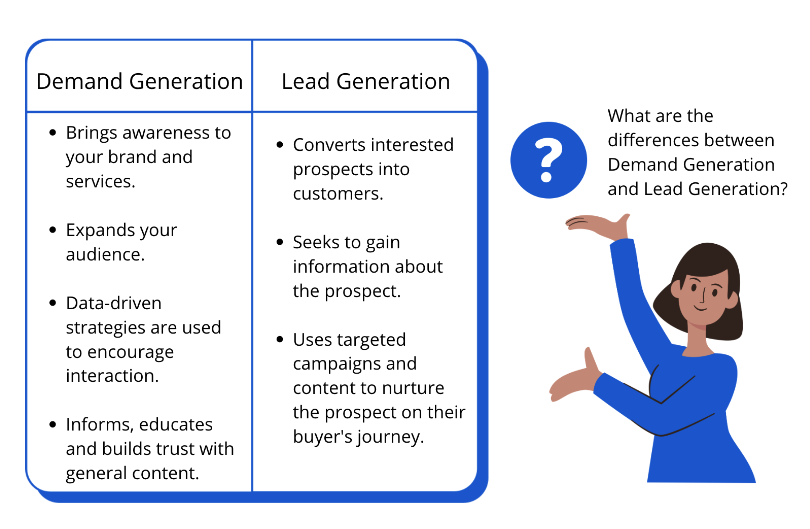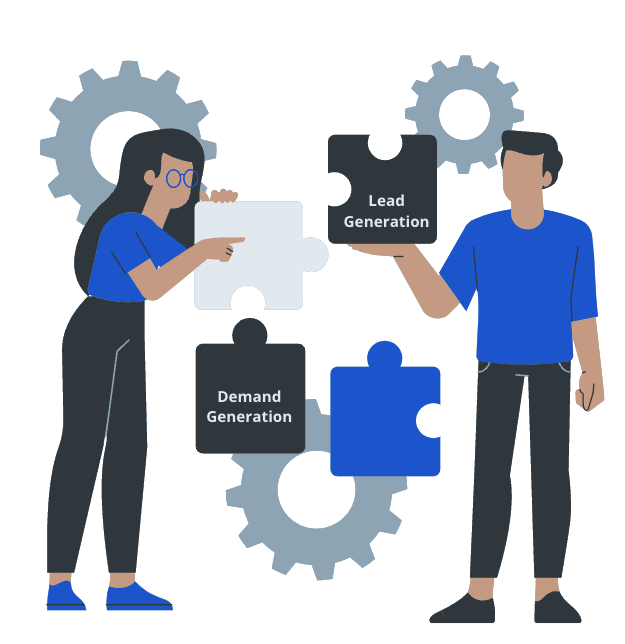Right now, Google is processing 99,000 searches every single second. A few moments ago you may have searched for “What is Demand Generation?” and ended up here. A Google search is what we do when we want information about a subject, product, or business.
Every Google search produces thousands of results, over hundreds of pages. The goal for every business, including yours, is to rank high enough that they appear on the first page, among the first few entries. If your B2B marketing team has done a good job of getting the website or content to rank using content marketing strategies, your solution will be among them.
Your potential customer has decided to click on a link to your website or a blog post related to their query. Now what? Your website and blog post has to deliver value but what is that exactly? Glad you asked because that’s where demand generation comes in:
Before we get into it, here are some of the questions that come up regularly:
What is Demand Generation?
In a nutshell, demand gen creates awareness and interest in your company, products, and services. It’s that very first click the prospect made to visit your website or blog. Your demand gen content should help your prospect name their problem, and position you as the trusted authority on the solution. The value to the customer: education & information. The value to you: the customer has found you.
Demand generation initiatives are usually fueled by having the right content, at the right time, for the right customer. It’s a long-term play that guides the customer along their journey and can take a while to show success.
Branding is also an essential part of demand generation. Some more well-known brands only have to rely on their brand reputation to create interest. Good branding fuels demand generation just as much as high-quality, valuable content! But there are also dangers of having your reputation precede you: You have to tightly control your brand image to make sure the brand-aware prospects don't lose the trust they had in you.
However, if you’re just starting or trying to strategically position your brand, demand gen should help you build those relationships. Usually, marketing and sales teams use a funnel to map each phase of a potential buyer’s journey to make each touchpoint visible.
The Journey Through The Funnel
The famous marketing and sales funnel is a visual representation of the customer’s journey. In its most basic form, the funnel has 3 phases: awareness, consideration, and conversion.

As you can see from the image, awareness sits at the top, representing the start of your relationship. These are data-driven strategies that come from two questions we marketers ask ourselves about our target audience:
What are the buyer’s pain points or problems they’re trying to solve?
How do they get information to help themselves?
There are many ways a potential customer becomes aware of you and your company:
Through a google search based on a question or need they have
They saw your ad on a website
They saw your activities on social media
Read a review about you on a review platform like G2
Great! You’ve gotten them to your front door but now you have to give them a reason to come in. Demand generation continues to help create those reasons. Your marketing and sales departments have to have content and resources available to accompany your prospects on their journey, no matter where they are in the funnel.
Every single contact point or content piece, whether it’s your company’s landing page, a social media snippet, or gated content, like a 10-page white paper, has its purpose. Their purpose is defined by data-driven strategies and the activities, highly targeted.
So which is more important?
Demand Generation vs. Lead Generation
Everyone loves a good rivalry. The world of tennis just lost one of its greatest rivalries of all time with Federer and Nadal. But do Marketing and Sales need a rivalry to execute successful demand generation or lead generation?
Let’s look at the funnel again, but in more detail:

You see that area of overlap on the left-hand side? During the consideration stage, both demand gen and lead gen come into play. If you’ve been focusing on which is better then you’re missing out on the opportunity to make them both work together for your customer.
But how exactly do they differ?
Key Differences Between Demand Generation and Lead Generation

What is Lead Generation?
Lead generation done well should encourage the potential buyer to go from curious to filling out a form. They are past the stage where they’re just “window shopping”, now they want to know more. Perhaps they filled in a form to sign up for your newsletter which starts the process of lead qualification.
A Lead isn’t Just a Lead
Any sales rep will tell you what a time-consuming effort sifting through leads can be. And just having a lead is not enough to make it work for your company. The person that filled in your form for the newsletter might not be your ideal customer.
According to Hubspot, 61% of B2B marketers rank lead generation as their number one challenge.
A lead has to fulfill certain requirements for a salesperson to follow up on them. This is where lead scoring comes into play. Your company’s sales department has criteria—an SQL (sales qualified lead] as does Marketing with their MQL (marketing qualified lead). In other words, high-quality leads.
We don’t have to go into huge detail about that now, but if you’re curious to know more we wrote about leads and what makes them qualified.
Basically, an MQL is a lead that has a high probability of becoming your next customer. These leads get handed over to Sales who then have their own lead-qualification process. HubSpot reported that only 56% of B2B organizations verify leads before they’re passed on to Sales.
If there two structures and processes that should be in place if you want to be assured of success are:
Sales and marketing alignment. The number of leads that get ignored or discarded by Sales will be drastically reduced because there’s a joint understanding of what a qualified lead is for your company.
Lead enrichment is where additional information is gathered and added to a lead. This ensures that the data that does qualify and get handed over is as complete as possible.
Why? To help your salespeople turn prospects into customers.
The Synergy of Demand Generation and Lead Generation
Remember our question from before about which is more important? You could say that lead generation is a sub-set of demand generation, but that doesn’t mean it’s less important. They both have important roles to play in the entire customer journey so let’s take a look at where they come together and shine:
The Sweet Spot Between Demand Gen and Lead Gen
This middle section of the funnel is where your prospect gets nurtured. So, there’s no time to pat yourself on the back. Yet. If planned well, your marketing team will have prepared relevant content for this part of the customer’s journey.
Lead Nurturing: Why is it important?
A garden with beautiful flowers doesn’t just happen. Throughout the year, different care has to be given to make them grow. The same with your leads—your marketing and sales team have to nurture them at all points of the funnel to add value and build trust so they can turn into customers.
Both the sales and marketing teams are active here and need to be aligned to make sure the lead doesn’t get lost on their journey. Awareness is great, of course, but lead generation drives the last half of the process that leads a prospect to become your customer.
But, Where Should You be Focusing Your Resources?
Well, that all depends on your needs as a company. Where are you losing people in your funnel? If you’re a newer company that’s trying to break into the market, start by prioritizing your marketing efforts—if you’re still having trouble getting people to sign up for your newsletter, or download a best practices checklist then take a look at your lead gen efforts.

Pro Tip: Take a look at your CTAs and optimize them for better conversion or do A/B testing for your landing pages to create the best version to promote more clicks and reduce bounce rates.
To achieve your ultimate goal, you’ll need some time to fine-tune your marketing and sales activities by implementing both demand and lead generation into your framework. The trick is, to make sure you don’t fall into the trap of believing that one can live without the other. This could hurt your bottom-funnel performance.
Conclusion: Stop Comparing and Start Leveraging!
Knowing the difference between demand generation and lead generation is the start, but your teams have to come up with joint strategies to effectively move your qualified prospects through the funnel. Sales Intelligence tools such as Echobot can be a handy tool to boost both your lead and demand gen!
Meet your customer where they’re at, then show them how to get to the finish line.
Always be ready to adjust your strategies if needed. There’s nothing more frustrating than a blocked funnel because customer needs have changed, but the funnel hasn’t. Create repeatable and scalable processes with demand and lead generation synergy to fully achieve your goals.
